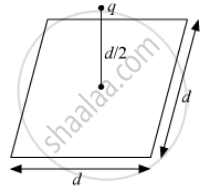Advertisements
Advertisements
प्रश्न
An infinitely long positively charged straight wire has a linear charge density λ. An electron is revolving in a circle with a constant speed v such that the wire passes through the centre, and is perpendicular to the plane, of the circle. Find the kinetic energy of the electron in terms of the magnitudes of its charge and linear charge density λ on the wire.
उत्तर
Infinitely long charged wire produces a radial electric field.
E = `lambda/(2piε_0r)` .............(i)
The revolving electron experiences an electrostatic force and provides the necessary centripetal force.
∴ eE = `(mv^2)/r` ...............(ii)
⇒ `(e.lambda)/(2piε_0r) = (mv^2)/r ⇒ mv^2 = (elambda)/(2piε_0)`
The kinetic energy of the electron,
K = `1/2mv^2 = (elambda)/(4piε_0)`
APPEARS IN
संबंधित प्रश्न
A 36 cm long sonometer wire vibrates with frequency of 280 Hz in fundamental mode, when it is under tension of 24.5 N. Calculate linear density of the material of wire.
Explain why, for a charge configuration, the equipotential surface through a point is normal to the electric field at that point
Obtain the formula for the electric field due to a long thin wire of uniform linear charge density λ without using Gauss’s law. [Hint: Use Coulomb’s law directly and evaluate the necessary integral.]
A point charge q is at a distance of d/2 directly above the centre of a square of side d, as shown the figure. Use Gauss' law to obtain the expression for the electric flux through the square.

Use Gauss' law to derive the expression for the electric field `(vecE)` due to a straight uniformly charged infinite line of charge density λ C/m.
Draw a graph to show the variation of E with perpendicular distance r from the line of charge.
Find the work done in bringing a charge q from perpendicular distance r1 to r2 (r2 > r1)
- Obtain the expression for the electric field intensity due to a uniformly charged spherical shell of radius R at a point distant r from the centre of the shell outside it.
- Draw a graph showing the variation of electric field intensity E with r, for r > R and r < R.
A solid metal sphere of radius R having charge q is enclosed inside the concentric spherical shell of inner radius a and outer radius b as shown in the figure. The approximate variation of the electric field `vecE` as a function of distance r from centre O is given by ______.

Draw a graph of kinetic energy as a function of linear charge density λ.
